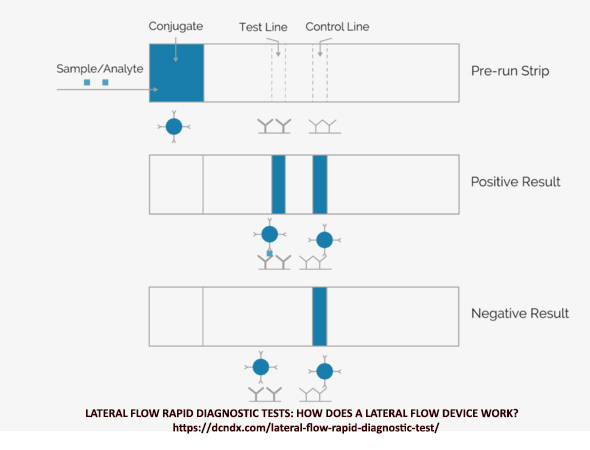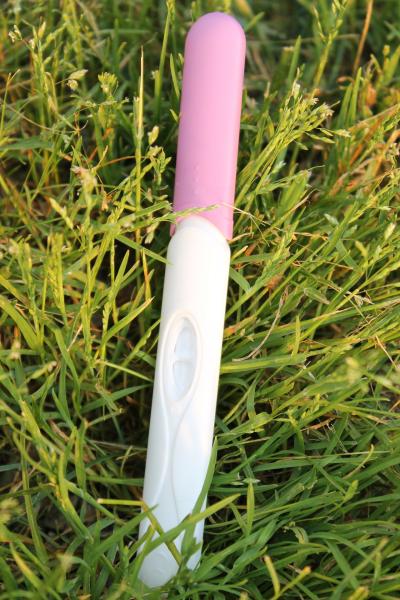For those in a rush, the technology has been around for quite some time. The test is not as accurate as a PCR test, especially among the asymptomatic, and it differs from other at-home tests being available without a prescription.
How does it work?
The technology, known as lateral flow immunoassay, is not new. It is the basis of the ubiquitous pregnancy tests that tell you yes or no.
A sample is taken using a cotton swab from your nose, and it is placed in a dropper containing a fluid to allow the particles within the sample to migrate through the test medium. The viral particles from your nose are then bound to a fluorophore – a chemical that can fluoresce, light up. This chemical mix is now put into the testing system that uses capillary action to pull the viral particles attached to the fluorophores across "capture zones" which contain complementary antibodies to COVID-19's N protein, the protein surrounding its DNA.
 The fluorescent information is captured in two test zones, one looking for COVID-19, the other looking for a common antigen found in nasal swabs to confirm the collection's reliability and the migration of the sample into the test system. An inboard analyzer evaluates that information and communicates it to the smartphone app that comes with the product. The entire test takes about 20 minutes.
The fluorescent information is captured in two test zones, one looking for COVID-19, the other looking for a common antigen found in nasal swabs to confirm the collection's reliability and the migration of the sample into the test system. An inboard analyzer evaluates that information and communicates it to the smartphone app that comes with the product. The entire test takes about 20 minutes.
The detection system of this device is quite different from those more familiar pregnancy tests. According to Dr. Sean Parsons, the CEO of Ellume, an Australian start-up, the detector is
"A quantum dot is a nano crystal which absorbs short wavelength light (ultraviolet light) and as it absorbs that light it bumps an electron into a high energy state. As it falls back down it releases another photon of light that is a longer wavelength (red wavelength/infrared wavelength)."
The detection of the emitted light explains the need for an on-board processor. The technology costs only a few dollars and represents quite a bit of money spent on R&D. Still. It reduces the system's cost to a few dollars – a significant consideration in mass testing or for the use of this test outside first-world countries. The technology has already been applied to seasonal flu and TB by the company as an inexpensive means of reliable point of care (physician office) diagnostics.
How accurate is the test?
Compared with a PCR laboratory test acting as the gold standard, the Ellume system showed a true positive rate of 96% in symptomatic patients and 91% in asymptomatic individuals. It demonstrated a similar pattern for establishing a true negative, 100% in symptomatic patients, and 96% in the asymptomatic. The test data comes from a small sample of 198 subjects, so the true positives (sensitivity) and true negatives (specificity) will likely diminish with large scale testing. [2]
Here is the FDA's take
Positive results indicate the presence of viral antigens, but the clinical correlation with past medical history and other diagnostic information is necessary to determine infection status. Positive results in an asymptomatic individual are presumptive and may need to be confirmed with a molecular assay. …
Negative results are presumptive and confirmation with a molecular assay, if necessary, for patient management may be performed. Negative results do not rule out SARS-CoV-2 infection and should not be used as the sole basis for treatment or management decisions for the individual, including infection control decisions. Negative results should be considered in the context of an individual's recent exposures, history and the presence of clinical signs and symptoms consistent with COVID-19.
It represents another tool in the COVID-19 toolbox, and it may help to alleviate fears and concerns. With a bit of luck, it may well ease the lockdowns.
[1] FDA Approval of Ellume Home Test
[2] Data were taken from Ellume's website
Image of typical lateral flow test taken from DCN-dx website: LATERAL FLOW RAPID DIAGNOSTIC TESTS: HOW DOES A LATERAL FLOW DEVICE WORK? material from their website was used in the development of text in this article.




